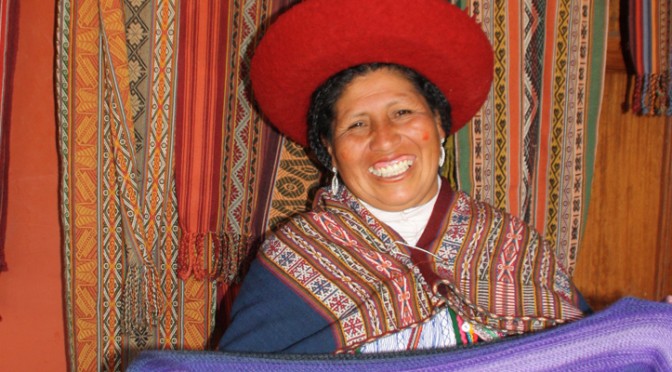- Peru’s Sacred Valley weaves together past and present in colorful fabrics and flavorful foods that can be happily explored in a day before embarking a luxury train to the most famous destination: Machu Picchu. Flying from Lima, the current day capital, to Cuzco, once a capital of the vast Incan empire, I transferred from the modern day Pacific seaside to the cultural gem in the Sacred Valley of the Andes mountains. After a savory fusion lunch in Cuzco, I then enjoyed a road trip to more rural sites worth visiting – Chimchero, Moray, and Ollantaytambo- to experience the cultural weave of old and new.
The Incans grew thousands of different kinds, sizes, and colors of potatoes in the 15th century and even invented “freeze dried” long before the space program. Hip restaurants now are being creative at serving potatoes and all kinds of culinary pleasures these days as Peru increasingly becomes a gastronomic destination.
The waiter of Limo restaurant in Cuzco brings in an appetizer described on the menu as “Golden fried yucca balls stuffed with andean cheese in a huancaina sauce and micromix salad on the side.” My selection for main course: “Trout prepared in a sudado of its own broth, aji amarillo, tomato, onion and white wine over tender yucca.” For dessert : “Purple corn shimmered with spices, apple, pineapple and quince fruit.”
At almost 12,000 feet altitude, Cusco can take some acclimatizing. In fact check with your doctor before going from sea level (coastal Lima) to Andean Cusco. Locals recommend the Coca tea saying the stimulant makes breathing easier in the thinner air. Warning: My doctor says the coca could show up in a drug test even three weeks later. The original Coca Cola drink so popular in the US had cocaine in it, now illegal.
Chinchero
Tea was also offered to welcome us to Chinchero, 35 kilometers northwest of Cuzco in the Sacred Valley. Chinchero is a working demonstration center of Andean textiles. Llamas, vicunas and alpacas all provide raw material, and different natural substances are used for dyes. The women weave scarves, blankets and hats for their own use and for sale.
Moray
Many kilometers on a dirt road later, Moray is an impressive archeological site believed to be an Incan Agricultural experimental station designed with temperature variances at different levels to test and adapt foods gathered within the Incan Empire.
Ollantaytambo.
The Andean Village of Ollantaytambo near the PeruRail train station is well worth a visit before trekking or training to Machu Picchu. Some of the narrow streets, water channels and stone homes date centuries back to Incan times, reminders of the sophisticated irrigation systems and urban designs of the mighty Empire.
Ask your guide or hotel to help with a peek into a working home. My guide, Ruben Tello Velasque, said, “The typical family has six or seven kids, four or five dogs, three or four cats and 200 guinea pigs.” The Guinea pigs that live with the family are a popular food source.
The past and present weave in this home too. Both electrical power and a skylight offer illumination. One corner of the home has guinea pigs and in another corner a kitten sits near fabrics for sale to tourists. A potato dish is being prepared next to a plastic pitcher under a stone wall which holds ancestor skulls. Nearby woven goods are available for visiting tourists.
A beautiful train ride away, Machu Picchu sits majestically as a monument to the Incan past. Around it, in the Sacred Valley, the new and old ways intertwine for the curious traveler to explore.
For more information on travel in Peru and for road trip bonuses between Cuzco and the train ride to Machu Picchu, contact www.Peru.Travel
Lisa TE Sonne for LuxuryTravelMavens.com
All photos by © Lisa TE Sonne from October, 2012 trip, to be used only with permission. Please add comments below about your own travels or write her Lisa@LuxuryTravelMavens.com Follow her on Twitter: @ExploreTraveler

















Recent Comments